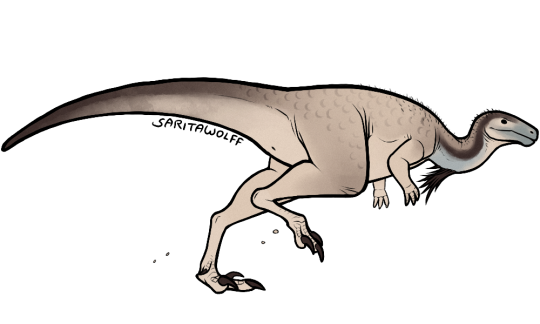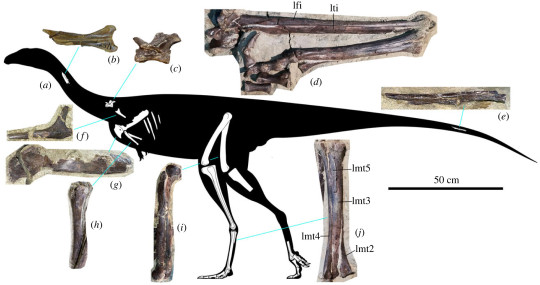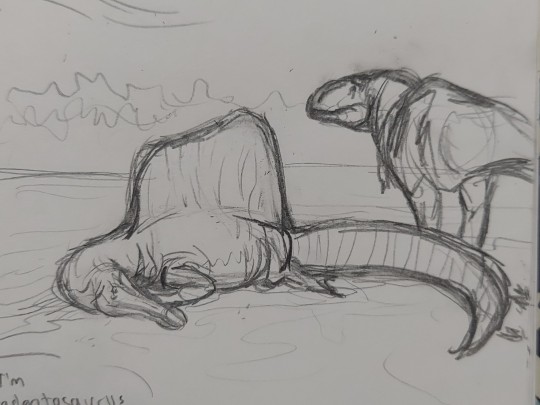#noasaurid
Explore tagged Tumblr posts
Text
#Paleostream 22/03/2025
here's today's #Paleostream sketches!!!
today we sketched Sauroposeidon, Thescelosaurus, Vespersaurus, and Knoetschkesuchus




#Paleostream#paleoart#digital art#paleontology#digital artwork#artists on tumblr#palaeoart#digital illustration#sciart#id in alt text#dinosaur#sketch#sketches#paleoblr#palaeoblr#sauropod#Sauroposeidon#oviraptorosaur#Microvenator#ornithischian#Thescelosaurus#theropod#noasaurid#Vespersaurus#pterosaur#tapejarid#Torukjara#croc#eusuchian#Knoetschkesuchus
163 notes
·
View notes
Text
Archovember 2024 Day 7 - Vespersaurus paranaensis

The rare noasaurids were a family of theropod dinosaurs belonging to the group Ceratosauria, and were related to the short-armed abelisaurids. One noasaur, Masiakasaurus, brought the family into the limelight recently with its appearance on Prehistoric Planet. But in Cretaceous Brazil, a different noasaur left its strange, monodactyl footprints across the sand. Vespersaurus paranaensis had two “killing claws”, on each foot, but not like a Velociraptor, or a Balaur, or even like modern Accipitriformes. Instead, it walked on its middle toe, while its 2nd toe and outer toe were raised off the ground. This may have been an adaptation to moving swiftly across the hot sand of the Botucatu Formation, a vast Cretaceous desert. Such an adaption has not been found in any other archosaur. Vespersaurus probably didn’t actually use these claws for hunting, and was likely a generalist, chasing down small, fast animals, opportunistically scavenging the kills of other predators, or hunting weak and injured animals. It may have instead used its claws in powerful defensive kicks, similar to modern cassowaries.

Other named species have yet to be found in the Botucatu Formation. Aside from Vespersaurus, other fossils include indeterminate coelurosaurs, ornithopods, lizards, tritylodontids, and mammals.

This art may be used for educational purposes, with credit, but please contact me first for permission before using my art. I would like to know where and how it is being used. If you don’t have something to add that was not already addressed in this caption, please do not repost this art. Thank you!
#Vespersaurus paranaensis#Vespersaurus#noasaur#noasaurid#theropods#saurischians#dinosaurs#archosaurs#archosauromorphs#reptiles#Archovember#archovember2024#dinovember#Dinovember2024#DrawDinovember#DrawDinovember2024#SaritaDrawsPalaeo#early cretaceous#middle cretaceous#late Cretaceous#brazil#Argentina#Botucatu Formation
19 notes
·
View notes
Note
trick or treat :3c

Vespersaurus by Juanet
9 notes
·
View notes
Text

Kiyacursor, I also did an alternative version with lighter feathers but I decided that it'd look better with darker feathers. (lmk if you want to see that one).
#art#my art#digital art#paleoart#paleontology#palaeoblr#archosaurs#dinosaurs#theropods#ceratosaurs#noasaurids#kiyacursor#queue
102 notes
·
View notes
Text

A young berthasaura narrowly escapes the jaws of a predatory vespersaurus. Despite appearances, these two are actually quite closely related, both being part of the clade noasauridae. These were a group of ceratosaurid theropods that were quite varied in forms, among them small hunters and beaked herbivores that lost their teeth as they grew up.
Not entirely sure whether these two lived together but I really like the contrast of how different yet also how close these two are. Also vespersaurus is one my favourite dinosaurs ever.
5 notes
·
View notes
Text

A noasaurid falls off a cliff. Was he pushed? We'll never know.
#artists on tumblr#digital illustration#digital art#dinosaurs#krita#paleoart#paleontology#dinosaur#palaeoblr
558 notes
·
View notes
Text

Kiyacursor, a newly described noasaurid theropod dinosaur, running around on its strange, ostrich-like feet.
430 notes
·
View notes
Text
Kiyacursor longipes Averianov et al., 2024 (new genus and species)

(Type specimen of Kiyacursor longipes, from Averianov et al., 2024)
Meaning of name: Kiyacursor = Kiya River runner [in Latin]; longipes = long foot [in Latin]
Age: Early Cretaceous (Aptian)
Where found: Ilek Formation, Kemerovo Oblast, Russia
How much is known: Partial skeleton of one individual including several vertebrae and limb bones. A partial neck vertebra found at the same site may belong to the same individual.
Notes: Kiyacursor was a ceratosaurian theropod. It resembles the Late Jurassic ceratosaurs Elaphrosaurus of Tanzania and Limusaurus of China in having relatively elongate lower legs and feet, suggesting that it was well adapted for fast running. The type specimen of Kiyacursor is estimated to have been 2.5 m long in total body length, but it probably had not finished growing when it died.
Although ceratosaurs are known from the Late Cretaceous of Europe and especially the Southern Hemisphere, Kiyacursor is the youngest known ceratosaur from Asia. In addition to Kiyacursor, the Ilek Formation has produced fossils of various other animals that are more characteristic of Jurassic ecosystems, including certain types of proto-salamanders, proto-crocodylians, and proto-mammals. This may indicate that what is now Western Siberia acted as a "lost world" for some Jurassic animal groups during the Early Cretaceous.

(Select bones and schematic skeletal of Kiyacursor longipes [scale bar refers only to the skeletal and not to the photographs of bones], from Averianov et al., 2024)
Reference: Averianov, A.O., P.P. Skutschas, A.A. Atuchin, D.A. Slobodin, O.A. Feofanova, and O.N. Vladimirova. 2024. The last ceratosaur of Asia: a new noasaurid from the Early Cretaceous Great Siberian Refugium. Proceedings of the Royal Society B 291: 20240537. doi: 10.1098/rspb.2024.0537
77 notes
·
View notes
Text
sometimes i wake up and i remember that I LOVE DINOSAURS !!!!!! RAAAAGHHHH !!!!!!! anyways anyone else ever think about the kem kem beds. because i do.
kem kem beds save me. save me kem kem beds. the disproportionate split between large herbivores and megatheropods enamors me. what do you mean theres just only sauropods and no other large herbivores. what do you mean theres like 20 different large theropod species running around at the same time. why are there fish that damn BIG. what even are noasaurids. also spinosaurus is here.
kem kem group so fine kem kem group divine. my roman empire is thinking about how the ecosystem of the kem kem beds was so incredibly diverse that it allowed for all of these different VERY LARGE carnivores to coexist because they all occupied different niches in the environment. which just totally crumbles the stereotype of Big Theropod Deathmatch because uh yeah, sorry jw bros, we have proof of some of the largest theropods in history all living in the same place at the same time!!! successfully!!! animals do not just go around beefing and fighting one another 24/7, especially carnivores. carcharodontosaurus and spinosaurus are not fistfighting everytime they see one another. spinosaurus is busy sleeping like a log on the riverbank and carchar is just coming by to get a drink. carchar accidentally steps on spino's tail and the spino snaps at it but misses completely because its half asleep and stupid. carchar walks away. they are just animals !!! and every ecosystem is incredibly complex and i love that even though we only have fossils and rocks to go off of this fact is SO evident across the globe but kem kem beds is so special to me. in my heart. anyways very rough sketch to go along with this train of thought.

i miss you kem kem beds. sighs dreamily
#dinosaur#dinosaurs#paleontology#paleoblr#fossils#spinosaurus#carcharodontosaurus#sigh#i miss u kem kem group .... every day#dinosaurs being treated like any other animal ... something i savor more than anything#rodtalks
102 notes
·
View notes
Text

Refuge, an artifical earth-like planet, it has a rich atmosphere and geologic activity controlled by giant ancient machines deep in its crust.
It was seeded with late cretaceous fauna and flora. With oviraptors, small abelisaurids, noasaurids, dromys and more. Which then evolved into tremendous new species.
135 notes
·
View notes
Text

Another day, another dinosaur. This time, it's the small but fast Velocisaurus unicus 💨
There aren't many specimens of this dinosaur and I haven't drawn an abelisauroid, let alone a noasaurid ever, so I went for the cartoony style to hide any anatomy mistakes xD
I'm happy to learn more so if you have any info or advice, let me know! ☺️
71 notes
·
View notes
Text
#LemuriaChallenge - Submission 1
my first submission to the #LemuriaChallenge, assorted non-avian dinosaurs of the savannah and surrounding areas





#LemuriaChallenge#speculative evolution#speculative biology#alternate history#worldbuilding#spec evo#spec bio#speculative zoology#dinosaur#sauropod#noasaurid#titanosaur#abelisaurid
77 notes
·
View notes
Text
Fossil Friday: Argentinosaurus

Argentinosaurus is a titanosaur from late Cretaceous Argentina. The animal is very fragmentary with only 14 known elements of which only two are complete.

So, how do we know it's the heaviest land animal to ever walk the earth? Well, we don't actually. We need more pieces of the puzzle before we can accurately answer that question. We can, at the very least, put in a clade though.
In a paper describing the holotype of Argentinosaurus, we can see the characters it possesses that place it within titanosauria:
"Argentinosaurus huinculensis is identified basically with Titanosauria, by the presence of diverse characters whose association is characteristic of this clade, and that have in part been already been pointed out and illustrated by Powell (1986): a) opisthocoelous dorsal vertebrae with relatively small, elliptic pleurocoels, located in the middle and anterior sector of the vertebral body, in a wide pleurocoelic depression of 8 oval form, more wide in the anterior sector than in the posterior; b) presence of very clear, angular fossae, in the lateral face of the neural arch of the dorsal vertebrae; c) neural spines of the anterior dorsals rather flat, wide transversely, and without vestiges of bifurcation; d) presence of large bony cells in the entirety of the spongy tissue of the dorsal and sacral vertebrae." (https://www.naturalhistory.si.edu/sites/default/files/media/translated_publications/Bonaparte%26amp%3BCoria_93.pdf)
Argentinosaurus was found in the Huincul Formation composed of green and yellow sandstones up to 820ft (250m) thick. It is thought to represent a drainage system of a braided river.

Plants known from this formation include hornworts, liverworts,


ferns, clubmosses,


gymnosperms (including gnetophytes like ephedra and conifers)


and angiosperms.

Animals found in this formation include lungfish, gar,


turtles, squamates,


sphenodonts, crocodiles,


and many dinosaurs including titanosaur Choconsaurus, rebbachisaurids Cathartesaurus and Limaysaurus, carcharodontosaurid Mapusaurus, abelisaurids Skorpiovenator, Ilokelsia, and Tralkasaurus, noasaurid Huinculsaurus and paravian Overoraptor.

Tune in on Monday to learn all about diplodocids in more detail. Fossilize you later!
#paleontology#fossils#dinosaur#sauropod#titanosaur#south america#argentina#argentinosaurus#huincul formation#paleoenvironment#paleobiology#science education#science
24 notes
·
View notes
Text

A pair of fossilized vertebrae of an indeterminate theropod, possibly an abelisauroid from the Kem Kem Group in Taouz, Morocco. It's hard to say what species it belongs to, whether it is an abelisaurid or a large nosasaurid, or something else entirely. Cf. Rugops primus and Deltadromeus agilis are possible contenders assuming the latter is a true noasaurid. There is some typical Moroccan glue that slathered onto the specimen that is difficult to remove without damaging the bone, but for the most part, it seems mostly natural.
#fossils#dinosaur#paleontology#palaeontology#paleo#palaeo#rugops#deltadromeus#abelisauridae#noasauridae#theropod#cretaceous#mesozoic#prehistoric#science#paleoblr#デルタドロメウス#ルゴプス#アベリサウルス科#ノアサウルス科#恐竜#化石#古生物学
8 notes
·
View notes
Text

Baleen meditate in the middle of a field as Varinul approaches, the little noasaurid is curious about this strange figure.
16 notes
·
View notes
Text

Rupesteryx Oropes
Mountain-footed Cliff feather
An alpine-dwelling, 3meter long, herbivorous Noasaurid native to Lemuria's Highlands.
Using their sharp beaks as digging tools and their serrated toes to grip surfaces these agile animals are perfectly adaptad to mountaineering. They have very thick eyelids acting as sunblockers giving them an annoyed look. Feeding mostly on the sparse alpine vegetation.
3 notes
·
View notes